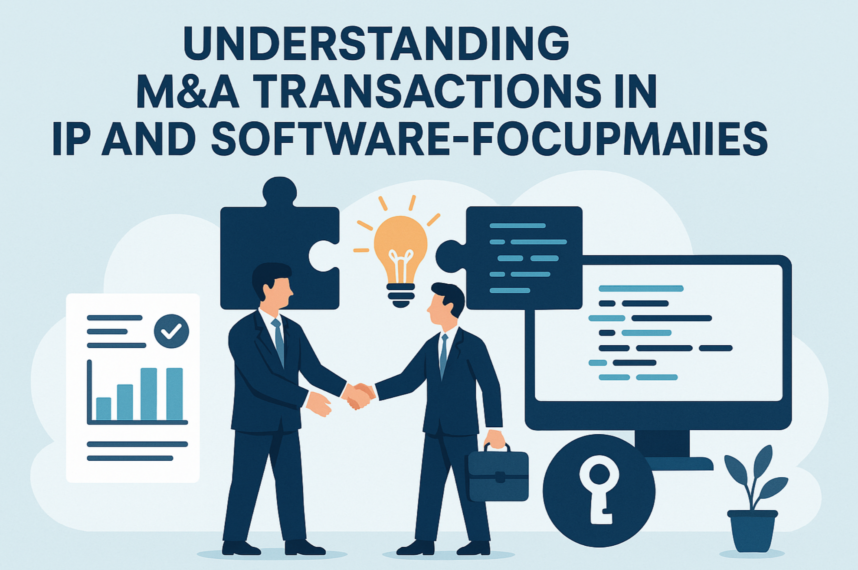Mergers and acquisitions (M&A) are complex processes that can significantly impact the future of companies involved. When the target company holds valuable intellectual property (IP) and software assets, the stakes are even higher. This blog post aims to provide a high-level primer on M&A transactions with a focus on IP and software companies, highlighting key considerations and best practices.
The Importance of Due Diligence
Due diligence is the backbone of any successful M&A transaction. It shapes core deal terms, transaction structure, and determines whether the deal moves forward. For companies where IP is the key asset, due diligence becomes critical yet less straightforward. Practitioners must navigate unique transaction structures and drafting considerations, often overlooked due to unwarranted assumptions about IP ownership and curing defects.
In M&A deals involving IP, due diligence must address several unique challenges:
- Ownership Verification: Confirming the ownership of IP assets is crucial. This includes tracing the chain of title and ensuring all assignments and name changes are properly documented.
- Security Interests: Identifying any liens or security interests against the target’s IP is essential to avoid future legal complications.
- Open Source IP: The use of open source code can impose restrictions or cause the target to lose IP protections, making it a critical area of focus during due diligence.
- Reversion Rights: Copyright assignments may be terminated by the author 35 years after the grant, which can impact the transaction.
- Intent-to-Use Trademark Applications: These applications cannot be assigned until proof of use in commerce has been filed, unless assigned to a successor of the business.
Types of Intellectual Property
Understanding the different types of IP is crucial for M&A transactions:
- Copyright: Protects original creative works fixed in a tangible medium of expression. Examples include company literature, software, and audiovisual content. Copyrights prevent infringement of works that are substantially similar and allow for rich licensing schemes. Registration with the Copyright Office is necessary for rights protection.
- Trademark: Identifies products or services of a particular source through names, logos, slogans, etc. Examples include company titles, product names, and visual logos. Trademarks prevent infringers from creating a likelihood of confusion and can be perpetual as long as the mark is in use in commerce. Registration with the USPTO is recommended but not required.
- Trade Secret: Confidential information continuously used by a business and not generally known within the industry. Examples include source code, customer lists, and proprietary recipes. Trade secrets provide protection through NDAs and secrecy policies and can be permanent depending on the scope and consistency of secrecy protection.
- Patent: Includes utility patents for new and useful processes, design patents for ornamental designs, and plant patents for new plant varieties. Patents provide a 20-year monopoly on the patented work, but protection ends thereafter. Registration is necessary for protection.
Types of Intellectual Property Table
| Type of IP | Protects | Protection Begins | Length of Protection | Registration | Example |
| Copyright | Creative works | Upon fixation | Life + 70 years | Gives extra protection | Books, paintings, recorded music |
| Trademark | Brand identifiers | Upon use in commerce | For as long as in use | Gives extra protection | “Coca-Cola” |
| Patent | Inventions | Upon registration | 20 years (14 for designs) | Required | Incandescent light bulb, Coca-Cola bottle shape |
| Trade Secret | Confidential business information | Upon creation | For as long as kept secret | None | KFC’s 11 herbs and spices |
Transaction Structures
Several transaction structures are common in M&A deals involving IP:
- Stock Purchase: The buyer acquires a controlling interest in the target company. Key questions include what IP the buyer wishes to acquire directly.
- Merger: Two companies combine into one surviving entity. Important considerations include which entity will survive and what IP the disappearing entity owns.
- Carve-Out Transaction: The buyer purchases a separate business from a larger enterprise. Key questions include what IP is owned by the target and its affiliates.
Phases of Inquiry
The M&A process generally involves several phases:
- Assessing Scope: Determine the importance of IP and data in the transaction.
- Planning and Executing Due Diligence: Thoroughly investigate the target’s IP assets.
- Papering and Negotiating: Draft and negotiate the transaction documents.
- Closing and Monitoring: Finalize the transaction and ensure ongoing compliance.
Due Diligence Considerations
Key due diligence steps include:
- Initial Inquiries: Request schedules of all registered and unregistered IP owned or licensed by the target. Identify critical IP for both the target’s business and the buyer’s future plans.
- Due Diligence Documents: Review agreements with individuals who may generate IP, registrations, licenses, and collaboration agreements.
- Chain of Title: Confirm the ownership trail of all IP assets. Remedy any gaps or inconsistencies before closing.
- Security Interests: Identify any liens or security interests against the target’s IP. Ensure all security interests are released before closing.
- Other Common IP Issues: Address issues like timely registration, reversion rights, open source IP, and assignment restrictions.
Typical IP Considerations
Copyright
- Are There Copyrights?: Company literature, copy, photos, audiovisual content, imagery, logos, software.
- How Do They Work?: Prevent infringement of works that are substantially similar. Allows for rich licensing schemes.
- For How Long?: Copyright is affixed at the time work is created and fixed. Registration with the Copyright Office is necessary for rights protection.
- Flashpoints and Flags: Ownership, licenses, transfers/assignments, ongoing or brewing disputes.
Trademark
- Are There Trademarks?: Company title/brand, product name/brand, visual logos, trade dress, sounds, colors, domain names.
- How Do They Work?: Prevents infringers from creating a likelihood of confusion. Confusion is measured by a multi-prong test.
- For How Long?: Potentially perpetual, generally for as long as the mark is in use in commerce. Registration with USPTO is recommended but not required.
- Flashpoints and Flags: Ownership, licenses, transfers/assignments, ongoing or brewing disputes.
Patent
- Are There Patents?: Inventions (mechanical, chemical, software), methodologies, recipes, formulas.
- How Do They Work?: Provides a 20-year monopoly on patented work, but protection ends thereafter. Registration is necessary for protection.
- For How Long?: Patents are term-limited by design but provide powerful tools for barring competitive use, importation, and sale.
- Flashpoints and Flags: Ownership, licenses, transfers/assignments, ongoing or brewing disputes.
Trade Secret
- Are There Trade Secrets?: Source code, customer lists, recipes, formulas.
- How Do They Work?: Provides protection through NDAs, policies, and secrecy.
- For How Long?: Potentially permanent, depending on the scope, consistency, and viability of secrecy protection.
- Flashpoints and Flags: Sufficient security, breaches, ongoing or brewing disputes.
Due Diligence Documents
Request the following documents during due diligence:
- Agreements with directors, officers, advisors, employees, contractors, consultants, interns, and other service providers who may generate IP.
- Employment and Independent Contractor Agreements.
- Work-for-Hire Agreements.
- Non-Disclosure and Confidentiality Agreements.
- Shareholder Agreement and Stock Purchase Agreements.
- All registrations and pending applications with the USPTO, Copyright Office, and international equivalents.
- All assignment and license agreements for IP (for both the target company IP and third-party IP).
- All collaboration or joint venture agreements involving IP.
Chain of Title
The “chain of title” for all target IP should be identified and confirmed prior to the transaction closing. To confirm the chain of title:
- Identify who created the IP and trace the paper trail from the creator to the target company.
- Check that all assignments and/or name changes for registered IP have been filed with the USPTO, Copyright Office, or foreign equivalent.
- Require the target company to remedy gaps and inconsistencies in the chain of title (both in the agreement paper trail and registrations) prior to closing.
Security Interests
Identify any security interests/liens existing and/or recorded against the target’s copyrights, trademarks, and patents. Security interests against IP may be filed with the Copyright Office and the USPTO. Security interests are “perfected” under the Uniform Commercial Code (UCC) by filing a UCC-1 with the state. Perfection gives the lender priority over others who may claim a security interest in the IP. Require the target company to record a security interest release with the Copyright Office or USPTO, as appropriate, where a security interest that is no longer active has been recorded prior to the transaction’s closing.
Other Common IP Issues
- Failure to Timely Register Copyrights: Statutory damages, attorneys’ fees, and other benefits are available in an infringement action if copyrights are timely registered.
- Reversion Rights: Copyright assignments (not WFH) may be terminated by the author 35 years after the grant (56 years for pre-1978 grants).
- Intent-to-Use Trademark Applications: ITU applications cannot be assigned until proof of use in commerce
Share this Post

